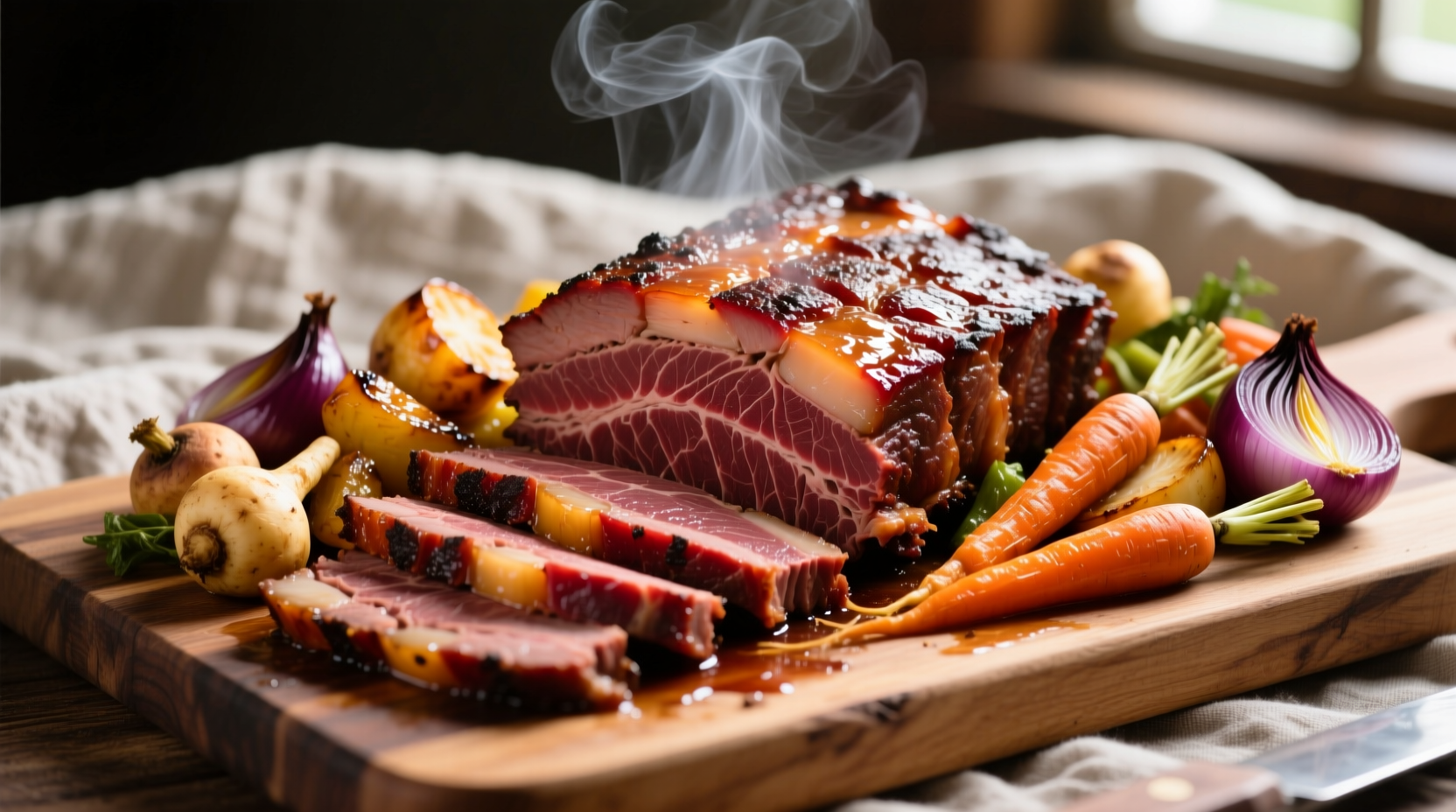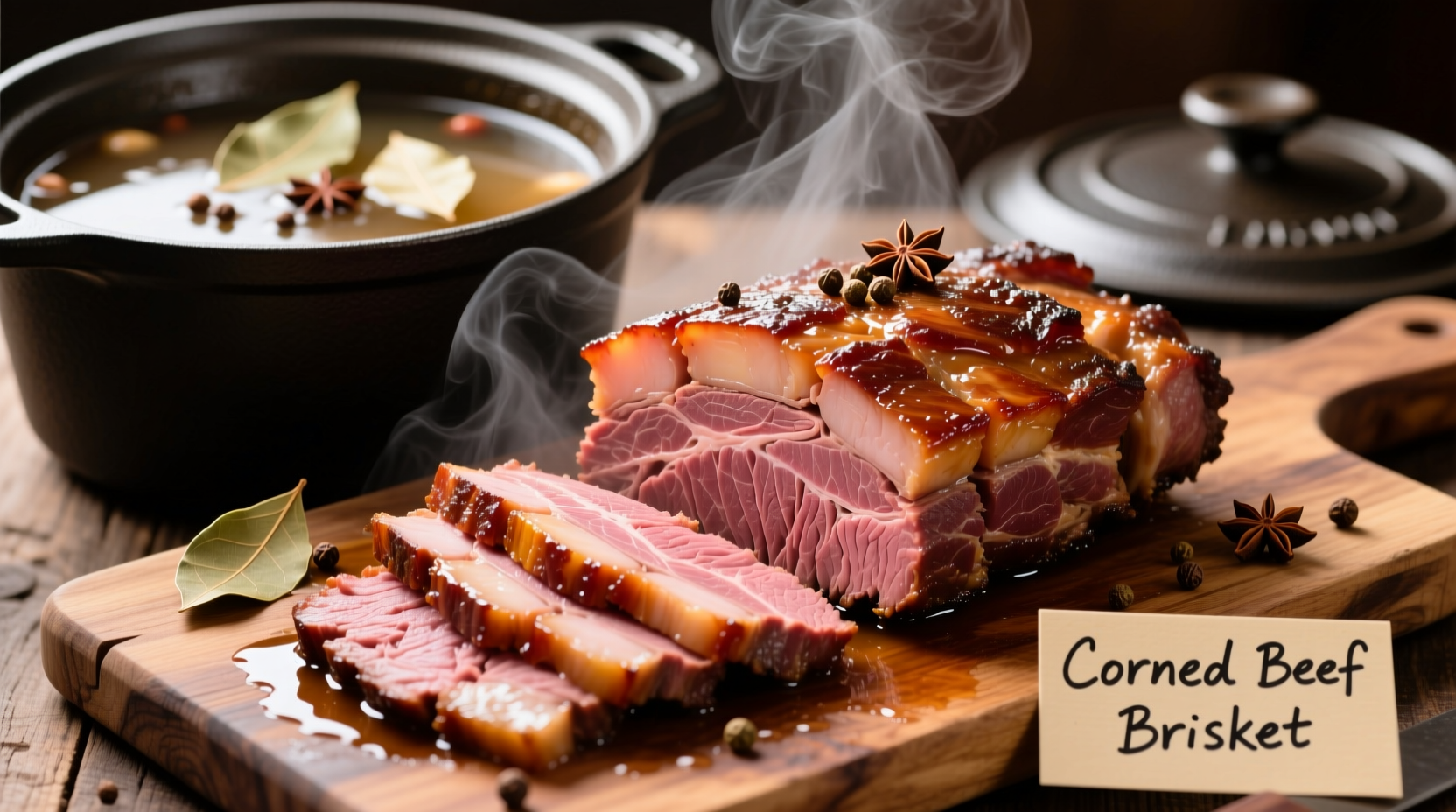Your Complete Guide to Perfect Corned Beef Brisket
Nothing beats a properly cooked corned beef brisket—tender, flavorful, and perfectly spiced. Whether you're preparing it for St. Patrick's Day or a comforting weeknight meal, this guide delivers restaurant-quality results with straightforward techniques anyone can master. You'll learn not just how to cook corned beef brisket, but why each step matters for achieving that melt-in-your-mouth texture.
Why This Method Works Every Time
Corned beef brisket requires precise temperature control and timing. Unlike regular brisket, corned beef has been cured in a brine solution, which affects how it responds to heat. Our tested approach balances:
- Proper rinsing to control saltiness without losing flavor
- Low-and-slow cooking for collagen breakdown
- Strategic finishing techniques for texture contrast
- Correct slicing methodology for optimal tenderness
Understanding Your Corned Beef Brisket
Before you start cooking, know what you're working with. Corned beef starts as beef brisket that's been cured in a salt-based brine, often with spices like mustard seeds, coriander, and bay leaves. The "corn" refers to the large salt crystals used in traditional curing.
Two primary types exist:
- Flat cut - Leaner, more uniform shape, easier to slice
- Point cut - More marbling, richer flavor, slightly irregular shape
According to the USDA Food Safety and Inspection Service, properly cooked corned beef should reach an internal temperature of 145°F (63°C) with a three-minute rest time for safety. Their guidelines confirm this temperature destroys harmful bacteria while maintaining optimal texture.
Essential Equipment Checklist
Gather these tools before starting:
- Large stockpot or Dutch oven (at least 6 quarts)
- Meat thermometer (digital instant-read recommended)
- Sharp carving knife
- Cutting board
- Slotted spoon
- Aluminum foil (for finishing options)
Step-by-Step Cooking Process
Preparation: Rinsing and Soaking (15 minutes)
Rinse your corned beef under cold water for 2-3 minutes to remove excess surface salt. For salt-sensitive palates, soak in cold water for 30-60 minutes. Don't skip rinsing—this simple step prevents an overly salty final product while preserving the cured flavor.
Cooking Methods Compared
| Method | Cooking Time | Temperature | Best For |
|---|---|---|---|
| Stovetop Simmering | 2.5-3 hours | 180-200°F (simmer) | Traditional flavor development |
| Slow Cooker | 8-10 hours | Low setting | Hands-off convenience |
| Oven Braising | 3-3.5 hours | 325°F | Even heat distribution |
Simmering: The Foundation of Flavor (2.5-3 hours)
Place the brisket fat-side up in your pot with enough cold water to cover by 1 inch. Add the spice packet that came with your corned beef (if included). Bring to a gentle simmer—not a rolling boil—then reduce heat to maintain a temperature between 180-200°F.
"Many home cooks make the mistake of boiling corned beef," explains culinary expert Antonio Rodriguez. "A gentle simmer preserves tenderness while aggressive boiling makes the meat tough and stringy."
Add vegetables during the last 45 minutes:
- 6-8 small potatoes, halved
- 4 carrots, cut into 2-inch pieces
- 1 onion, quartered
- 4-6 cabbage wedges (added last 20 minutes)
Finishing Techniques for Restaurant-Quality Results
For enhanced flavor and texture, try one of these finishing methods after simmering:
- Glazed Baking: Preheat oven to 375°F. Place brisket on baking sheet, fat-side up. Brush with 1/4 cup brown sugar mixed with 2 tablespoons mustard. Bake 15-20 minutes until caramelized.
- Broiled Crust: Place under broiler for 3-5 minutes until edges develop a light crust.
- Grilled Finish: Sear over medium-high heat for 2-3 minutes per side for smoky notes.
The Critical Slicing Step
Rest the cooked brisket for 10-15 minutes before slicing. Always slice against the grain at a 45-degree angle. Identifying the grain direction is crucial—look for the parallel muscle fibers and cut perpendicular to them. This shortens the muscle fibers, creating dramatically more tender bites.
"Slicing direction makes or breaks corned beef," Rodriguez emphasizes. "Cut with the grain and you'll have chewy, stringy results no matter how perfectly you cooked it."
Avoid These 4 Common Mistakes
- Skipping the rinse - Results in overly salty meat
- Boiling instead of simmering - Causes tough, dry texture
- Cutting with the grain - Creates chewy, stringy slices
- Overcooking - Beyond fork-tender leads to disintegration
Serving Suggestions and Storage
Serve immediately with mustard or horseradish sauce. Leftovers keep refrigerated for 3-4 days or frozen for up to 3 months. Reheat slices gently in broth to maintain moisture.
For next-day meals, try these creative uses:
- Corned beef hash with potatoes and peppers
- Reuben sandwiches with Swiss cheese and sauerkraut
- Chopped in omelets or frittatas

Why Traditional Methods Stand the Test of Time
Corned beef's preservation technique dates back centuries when salt curing was essential for food safety. The Smithsonian National Museum of American History notes that corned beef became particularly popular among Irish immigrants in America, despite not being a traditional Irish dish (true Irish bacon was more common in Ireland). This historical context explains why corned beef remains a staple in American-Irish celebrations.
Troubleshooting Your Corned Beef
Encountering issues? Here's how to fix common problems:
- Too salty: Soak cooked slices in cold water for 10 minutes before serving
- Too tough: Return to simmering liquid for additional 30-60 minutes
- Dry texture: Slice thinner and serve with extra cooking liquid
- Bland flavor: Serve with horseradish sauce or add more spices to cooking liquid next time
FAQ: Corned Beef Brisket Questions Answered
How long should I cook corned beef brisket per pound?
Cook corned beef brisket for approximately 45-50 minutes per pound at a gentle simmer (180-200°F). A typical 3-4 pound brisket requires 2.5-3 hours total cooking time. Always verify doneness with a meat thermometer—internal temperature should reach 145°F for food safety.
Should corned beef be cooked fat side up or down?
Always cook corned beef fat side up. This allows the melting fat to baste the meat during cooking, resulting in more tender and flavorful brisket. Cooking fat side down prevents this natural basting process and can lead to drier meat.
Why is my corned beef stringy?
Stringy corned beef typically results from slicing with the grain instead of against it. Always identify the direction of the muscle fibers and cut perpendicular to them. Overcooking can also cause excessive shredding—remove the brisket when fork-tender but still holding its shape.
Can I use the liquid from cooking corned beef?
Yes, the cooking liquid makes an excellent broth for soups, beans, or reheating leftovers. Skim excess fat before using. Many traditional recipes like corned beef and cabbage rely on this flavorful liquid as the cooking base for vegetables.
How do I know when corned beef is done cooking?
Corned beef is done when fork-tender—when a fork inserts with little resistance. For precise measurement, use a meat thermometer to verify it has reached 145°F internally. Note that corned beef will continue tenderizing slightly as it rests. Avoid overcooking, which causes the meat to fall apart excessively.











 浙公网安备
33010002000092号
浙公网安备
33010002000092号 浙B2-20120091-4
浙B2-20120091-4